Seasons – August 2021
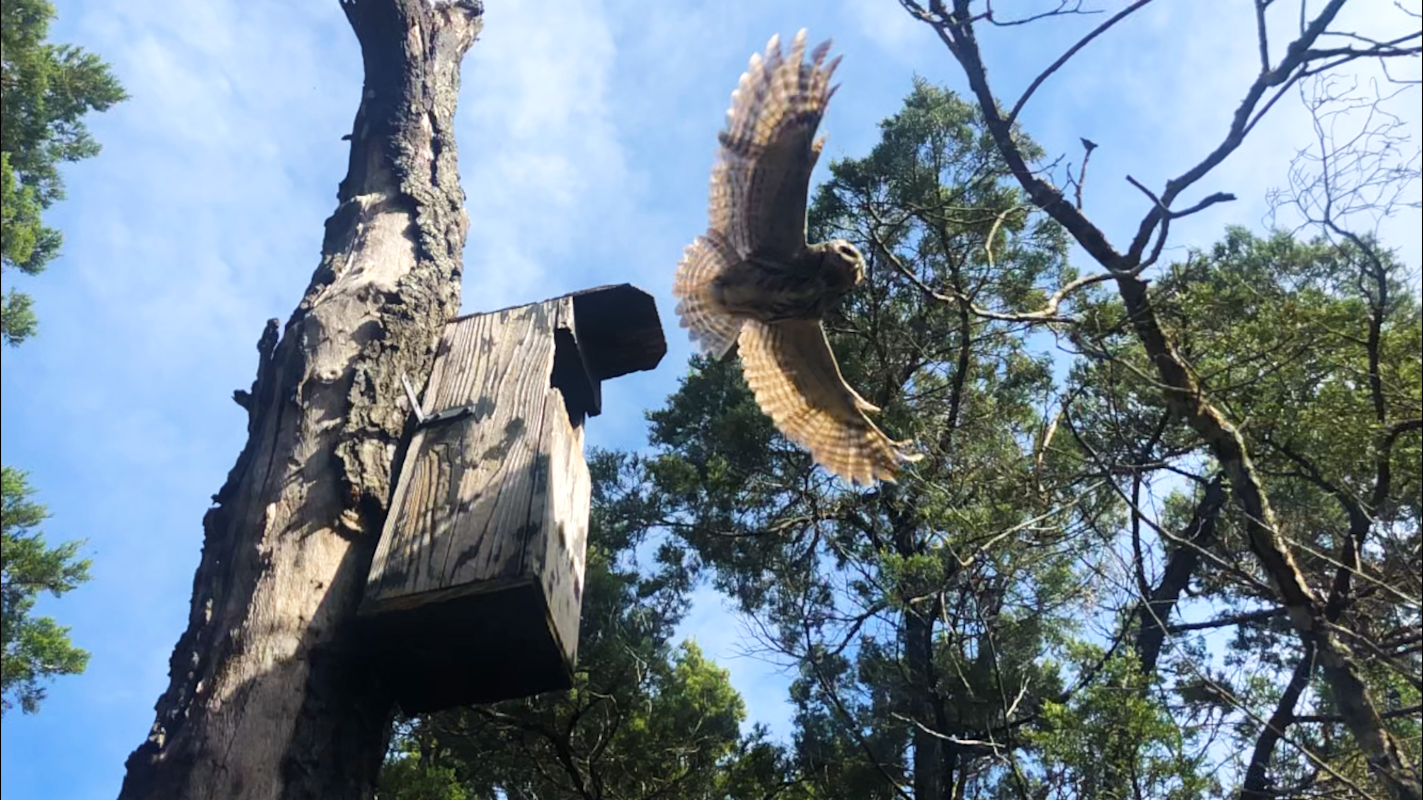
From the Plateau Land & Wildlife Management Team
As our summer season comes to a close and we look forward to cooler weather this fall, now is the time to be considering predators and predator control on your property. From Invasive Red Fire Ants (IRFA) to feral hogs, non-native predators can cause damage to our native flora and threaten native wildlife. There are many considerations landowners must take into account when controlling predator populations, including what predators are best to leave alone because of their benefits to your land.
In this issue of Seasons we will feature blogs about native and non-native predators, wildlife management activity suggestions for predator control, liability considerations for landowners, information about the Recovering America’s Wildlife Act, and more.
As always, we hope you enjoy all that this season and Seasons has to offer! Stay safe, and stay cool out there friends!
Until next Seasons,
The Plateau Team
Table of Contents
Dangerous Wildlife
Wildlife Management Activity Reminder: Predator Control
Serpents
Service Spotlight: Summer Webinars
On-Demand Webinar: Tools to Limit Your Risk & Protect Your Land
Recovering America’s Wildlife Act
Field Notes: Pictures & Highlights of Properties in Wildlife Management
News for Texas Landowners
Dangerous Wildlife
By James Hall, Senior Wildlife Biologist, Certified Wildlife Biologist and Registered Property Tax Consultant for Plateau Land & Wildlife

May be hazardous to your habitat.
Landowners are already aware of the splendor of rural Texas lands, with its rich scenery and unique mix of flora and fauna. Under the auspices of prudent stewardship, private lands can recover from the limitations imposed on them from intensive agricultural practices. As a result, the native beauty improves, plant and animal life can flourish, and the chances of encountering a broader diversity of wildlife become more likely as you walk and work the land. However, one may experience trepidation when coming across a wild animal in its natural habitat. Some species are considered scary or dangerous, while others have an impact on habitat health. Most wildlife generally avoid human contact, are not dangerous, and do not cause extensive damage to personal property or wildlands. However, it is important for land stewards to practice awareness when in the wilds, not only for safety during a wildlife encounter, but also to understand when control efforts are necessary.
Snakes
Snakes are a common predator in Texas, and one of the most feared wild animals. A mentality shared among some ranchers is that “the only good snake is a dead snake.” Snakes are generally regarded as dangerous, and from a safety perspective, they should always be treated with great respect. The average landowner can likely identify a copperhead or a rattlesnake, but snake species are numerous and diverse, and the vast majority are non-venomous. Some types mimic behavior or patterns of venomous species (e.g. bull snakes will vibrate their tails in dry leaves which sounds amazingly like a rattlesnake buzzing), thus it is safer to consider all snakes venomous and avoid handling them without a professional. However, this consideration does not demand a blanket kill-on-sight policy. Snakes play an important role in a balanced ecosystem, including contribution to rodent population control. Snakes can be easily avoided if caution is exercised at all times. A rattlesnake seeking shade under the steps of your front porch is another matter.
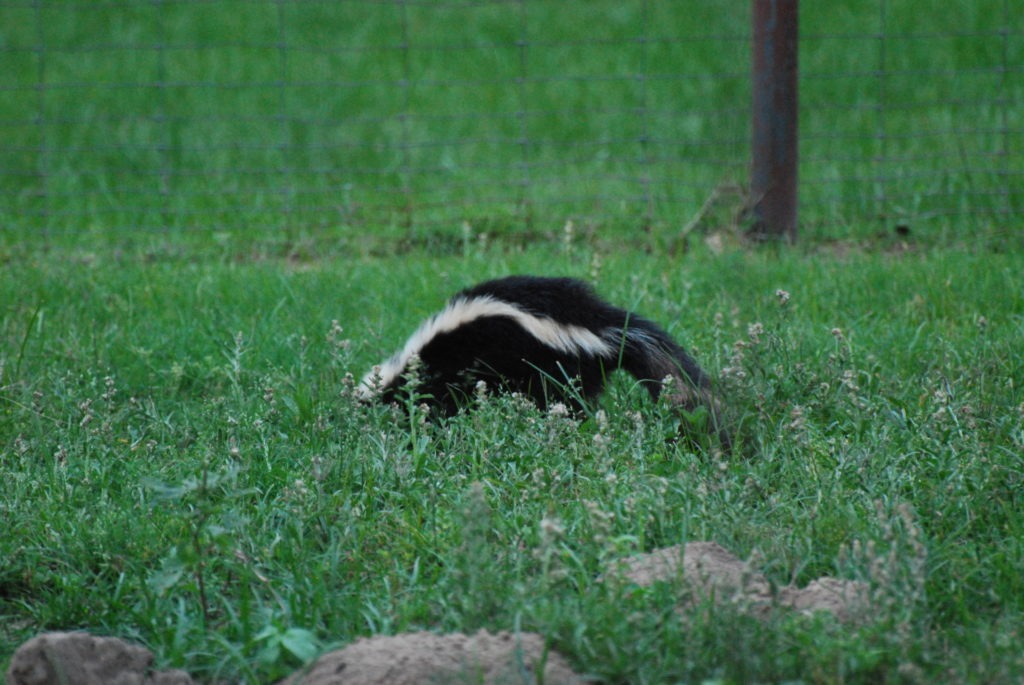 Varmints
Varmints
Just like snakes, not all varmints are dangerous nor do they require control, but virtually every ranch has a “nuisance” wildlife species of some kind. Familiar examples of these pests include imported red fire ants, feral hogs, raccoons, coyotes, foxes, skunks, beavers, and porcupines. With native predators, the “nuisance” is a people problem rather than a wildlife problem. Most landowners are excited to catch a glimpse of a fox (who eats more mice than game species), skunks are an important food source for Great Horned Owls, beavers create valuable wetland habitat that attracts other wildlife, and porcupines can damage trees but are rarely a real concern for tree health unless they are attacking an orchard.
Non-Native Predators
Fire ants and feral hogs are both non-native and cause considerable damage to habitat and native wildlife populations. Fire ants have devastating effects on local insect populations (an important food source for songbirds, turkey, and quail). They are also predators to native ant species, and aggressive to anything that comes into contact with their mounds, including an unsuspecting human foot. Feral hogs can be dangerous, but generally, avoid humans when encountered. More importantly, they compete with white-tailed deer and other animals for forage. They also contribute to erosion and the spread of non-native vegetation through their destructive rooting. As a result, the monitoring and control of these species should be considered a management priority and can count towards a property’s Wildlife Management Plan under the predator control category.
Native Predators
Raccoons are an example of a native predator and the source of much consternation to wildlife managers. These small carnivores are highly adaptable to human habitation in both urban and rural settings. Their populations can become exacerbated with the availability of human-provided food (deer feeders, unsecured trash), at which point control efforts may need to be implemented. Raccoons are also known to destroy deer feeders in an attempt to reach the available corn or protein pellets, though this practice does not constitute enough of a reason, from an ecological standpoint, to control their numbers. Utilizing a game camera, placed at a feeder or wildlife water source may help gauge raccoon numbers as well as other predator species and help land managers determine if control is necessary.
What many landowners and even land managers do not realize is that native predator control is often a futile effort. The desired outcome of increasing prey numbers is not always achievable. Predator reduction efforts to increase quail numbers are rarely successful. The level of control needed to have even a minor benefit is often beyond the abilities of most landowners. Any wildlife biologist will tell you that quality habitat is much more important and effective than predator control. Reducing deer predators such as coyotes may actually be counterproductive as deer are often a much larger problem for central Texas lands than any of the predators being controlled.
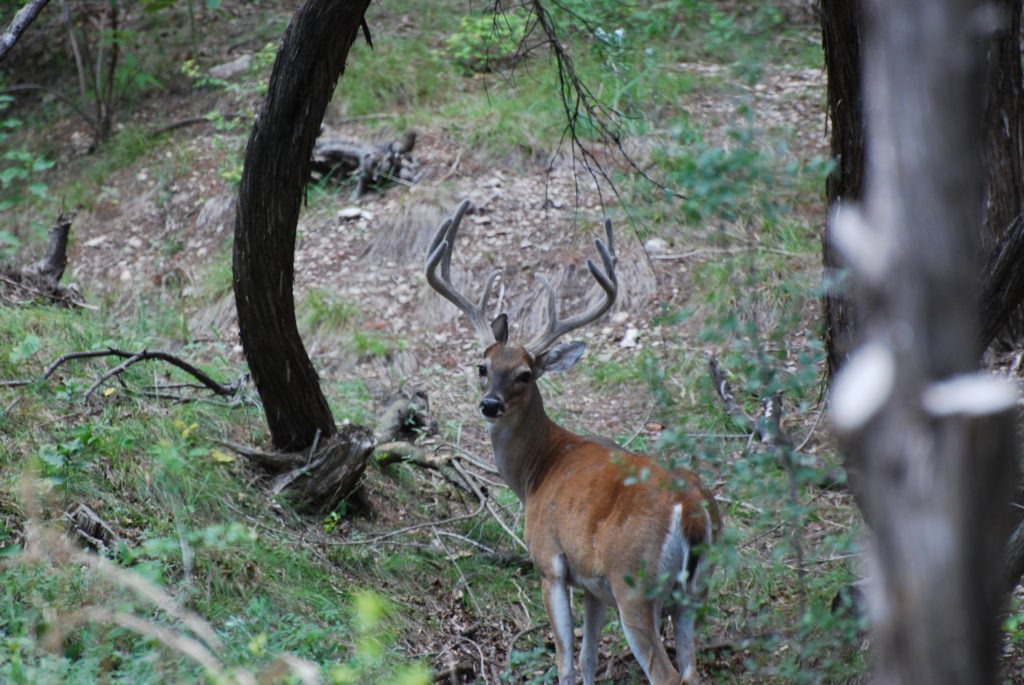 White-tailed Deer
White-tailed Deer
White-tailed deer are not predators, and yet can be far more harmful to the landscape than many of the aforementioned species. Rarely are deer a danger to humans, and most of the “threat” they pose relates to traffic accidents. However, a lack of natural controls and an increase in feeding has resulted in heavily inflated deer populations across the state, directly impacting desirable tree establishment. With high deer numbers, feral hogs, and increasing numbers of exotic deer, hardwood recruitment is exposed to heavy utilization and degradation. Implementing monitoring and control efforts, just like any other potential nuisance species, is strongly encouraged. Beyond observing scat and tracks, monitoring the habitat is important. Observable browse pressure on seedling oaks and desirable shrubs can offer some insight into deer numbers.
Rural Texas provides landowners with recreation and enjoyment. Wildlife watching and hunting are coveted activities in Texas, and the occasional startling encounter with an animal keeps us on our toes. Each wildlife species has a unique natural history, and understanding their place in the ecosystem will aid in avoiding injury and promote informed management decisions. If you have questions about the control of a species on your property, contact us at plateau@plateauwil1dev.wpenginepowered.com or (512) 894-3479.
Wildlife Management Activity Reminder: Predator Control
By Kameron Bain, Landowner Account Manager
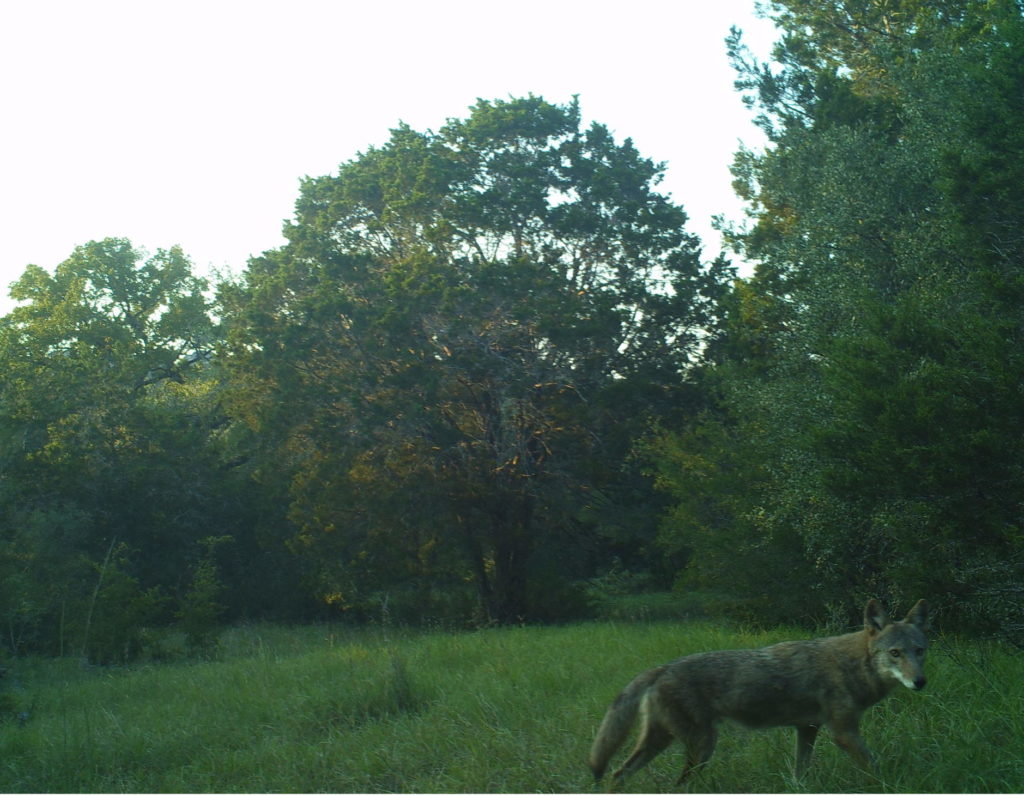 Predators Play an Important Role in Maintaining a Healthy Wildlife Habitat
Predators Play an Important Role in Maintaining a Healthy Wildlife Habitat
Within healthy habitats, native predators provide an essential function to complex ecological systems. Removal of key predators can have unintended, negative consequences. Predators play a contributory role in balancing prey density, which can contribute to improved species diversity and reduced habitat pressure.
A familiar example is witnessed within the Texas Hill Country. As wolves and screwworms (among others) were eradicated in the second half of the 20th century, white-tailed deer populations began to sky-rocket to the point of becoming grossly over-abundant. This artificial high density has resulted in landscape-scale habitat degradation from excessive use of preferred food resources (including trees, shrubs, vines, and forbs) by deer.
Predator Populations can Also Become Out of Balance
Artificially high or even moderate densities of opportunistic predators can place significant pressures on naturally low-density or recovering wildlife populations. Where the underlying goal of a land manager is to increase or stabilize target wildlife populations, predator management can serve as an important activity contributing to the measurable success of a Wildlife Management Plan. Our other management actions are sometimes the cause of this imbalance, such as feeding high volumes of corn that attract and support abundant raccoon and feral hog populations.
How does predator control fit in my Wildlife Management Plan?
Within any Wildlife Management Plan, predator control should be justified as a complementary practice to help mitigate detrimental effects that could compromise broader wildlife and habitat management goals.
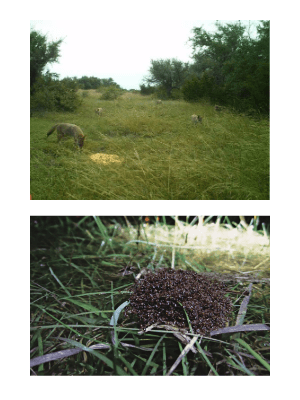 Predators come in many forms, but the most commonly managed species on private lands in Texas include –
Predators come in many forms, but the most commonly managed species on private lands in Texas include –
Native Predators:
- coyotes
- bobcats
- raccoons
- skunks
- cowbirds
- rat snakes
Non-Native Predators:
- feral hogs
- imported red fire ants
- starlings
- house sparrows
Concerning non-native predators, presence/infestation alone justifies control efforts. Non-native species prey both directly and indirectly on native wildlife resulting in an unnatural pressure to which native wildlife have not had an opportunity to adapt. Native predators present a more complex need for justification.
Top 3 Questions for Landowners Considering Predator Control
Land managers need to answer three important questions to justify reducing predator densities as part of a Wildlife Management Plan:
- Do the predators I intend to control directly or indirectly prey on my target species?
- Do predators occur in a density that can result in a measurable negative impact on my target species? (This impact can be cumulative with environmental factors such as drought and other disturbances.) As an example: if I have a deer overpopulation problem, coyote predation on deer fawns may help me achieve my management goals.
- Am I willing to engage in control of sufficient intensity and duration to make a real impact? Native predator control can require years of sustained, intensive effort to have a measurable impact and populations often bounce back quickly once control stops.
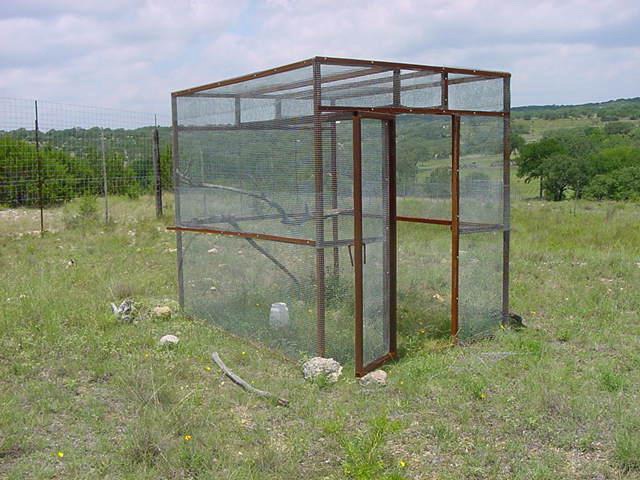 What qualifies as predator control?
What qualifies as predator control?
Proper trapping, active hunting, and harvest-on-site efforts are appropriate activities associated with controlling most predators. Another predator management technique involves monitoring and treating imported red fire ant (IRFA) infestation. Although IRFA and cowbird control are the only predator management activities with specific minimum intensities to qualify, a good faith effort should be made and documented when performing any predator control activity.
What DOES NOT qualify as predator control?
- Controlling small varmints when the defined target species are deer
- Controlling raccoons because they consume deer feed
- Killing non-predatory animals like porcupines
- Undocumented trapping efforts
- Undocumented hunting efforts
What is Plateau’s predator control solution?
Imported Red Fire Ant Treatment (IRFA): Armed with the right equipment and knowledge, our field technicians have the tools to fight back against this invasive pest. We spot treat whenever possible to reduce the amount of bait and limit impacts to native ants. Unlike treating fire ants on your own or hiring just anyone to throw bait on your fire ant mounds, Plateau will track and log where we treat the fire ants on your property, making this a favorite compliance activity for landowners in Wildlife Management valuation. Plateau recommends treating in late spring / early summer and again in the fall, so now is a great time for you to schedule a fall treatment.
Remote Camera Surveys: Monitoring predator populations is just as important as controlling them. Inferences can be made as to the relative abundance of predators on your property, but camera survey data is a more useful tool in determining when trapping/hunting efforts should be intensified or relaxed. They can also justify controlling a species that is otherwise an important member of a natural ecosystem. With this service, a Plateau professional will establish two or more baited infrared game camera stations for 10-14 days, and provide a detailed analysis of the captured pictures.
If you’re interested in learning more about how Predator Control can benefit your land and Wildlife Management goals or would like to schedule an IRFA treatment or Camera Survey, contact us at plateau@plateauwil1dev.wpenginepowered.com or (512) 894-3479.
Serpents
By Nick Fisher, Region Manager of Plateau’s Central Texas Region
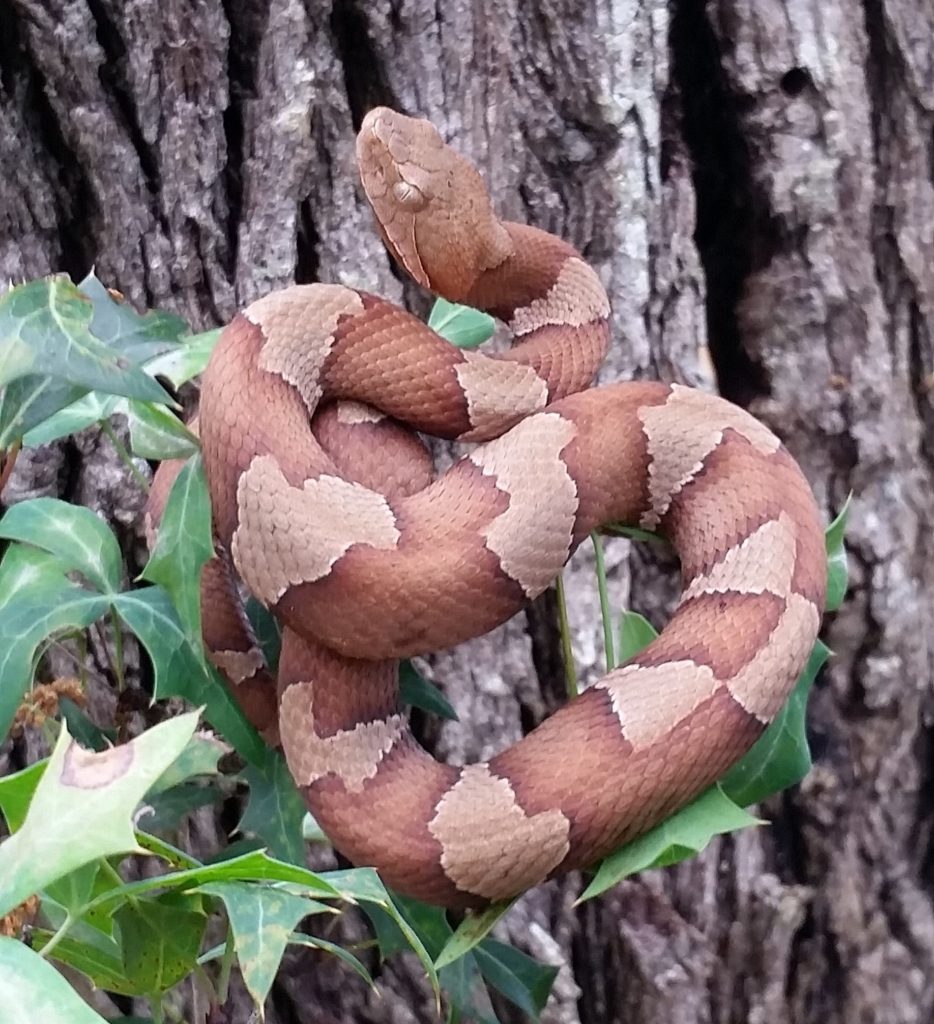
Photo of the venomous Texas Copperhead. Although in the same family as Rattlesnakes (Viperidae), the venom of a copperhead is not usually life-threatening to healthy adults, but medical attention is necessary.
Serpents have been feared and portrayed as evil creatures since the beginning of time, likely due to their ability to control their body without the use of limbs. After spiders, snakes are the most common animal phobia, often without a matter of size or species. Although all are similar in shape, snakes have adapted to thrive in almost all ecoregions of the world from arid deserts to tropical rainforests and even oceanic zones. In Texas, there are over 100 species of snakes currently described ranging over the vast mosaic of habitat the state offers.
As a naturalist and wildlife advocate, a common request from my peers is species identification. Nine out of ten times, a blurry photo of a non-venomous snake from the Colubridae family is sent to my phone with the caption, “rattlesnake?” (Often with a detached head.) If you didn’t spend years studying these patterns and colors, the common first response is to assume the most abundant and feared venomous species in our state – the rattlesnake. Patterns and colors of snakes often vary in order to camouflage with their environment – mostly in an attempt to avoid predation. Not only do many non-venomous snakes appear visually similar to rattlesnakes, but some may coil up and even imitate a “rattle” by use of shaking their tails in leaves or grass when approached. Others might flatten their heads and form a more triangular head shape, also mimicking the venomous Viper family of snakes (i.e. Rattlesnakes, copperheads, water moccasins).
Learning the natural history of snakes may alert you to where you might find one, or know where to avoid. As with most wildlife, being discovered triggers one of two responses – fight or flight. In my 15+ years of experience searching for and attempting to capture and study snakes, unless completely cornered (very difficult to corner a creature that has no limbs to get in the way) or already captured, the first thing these creatures want to do is get as far away from you, and as out-of-sight, as possible. If you have ever handled a snake, you probably know another common attempt at warding off predators is to “musk” or discharge a foul-smelling liquid to seem less appetizing.
Common Snake Species in Texas
You may find that different species of snakes display different temperaments, often even varying by the individual, so never assume because you picked up one species and didn’t get bit, that the next one will not bite you either. That being said, I have found water snakes from the Nerodia genus (non-venomous) often show aggression first, striking before making their way to the nearest body of water and swimming to safety. You might also find it surprising that the most common water snake in Central Texas is the Diamondback water snake (Nerodia rhombifer.) No, this is not a mix between a diamondback rattlesnake and a water moccasin. This is a thick-bodied, non-venomous snake that can stretch over 5’ in length and is found near most bodies of fresh water. Most of its day is spent basking until escaping to the water when threatened, usually long before you ever knew it was there and not resurfacing until completely safe to do so. The next most common water snake of our area is the plain-bellied water snake (Nerodia erythrogaster,) another non-venomous water snake with thick, dark bars across its back and an off-white underside. Plain-bellied water snakes exhibit similar life history to the diamondback water snake.

Photo of a Cottonmouth, aka water moccasin, a venomous snake in Texas.
Often similar in color to the non-venomous water snakes, the water moccasins, or cottonmouths, that inhabit our region vary from light brown to black and patternless, often losing patterns and darkening with age. The cottonmouth, Agkistrodon piscivorous can be distinguished from the others by close examination (sometimes closer than safe to do so). The elliptical-shaped pupils with a triangular head are the most visibly determinant characteristics of the viper family in Texas.
Alternatively, the one snake that does not fit into this category is a member of the Elapidae family (same as cobras) is the coral snake, (Micrurus tener.) The common rhyme to remember is “Red on yellow, kill a fellow; red on black, friends with Jack” (or venom lack). Although the coral snake is an elusive, relatively timid species that is rarely seen compared to the other venomous snakes of our region, they exhibit fixed fangs that can deliver a painless bite injecting neurotoxic venom into the bloodstream. The “red on black” refers to a non-venomous snake of similar size and colors to the coral, the milksnake, Lampropeltis triangulum.
Rattlesnakes are the most widespread species of venomous snakes in Texas and therefore account for the most bites by a venomous snake, although only about 1-2 of the states’ bites are fatal each year and the antivenin is likely readily available when seeking medical treatment. Copperheads and cottonmouths account for less than 5% of the deaths in the U.S. due to their less potent venom that rarely requires antivenin. Of all encounters I have experienced, even rattlesnakes will likely attempt to escape before confronting a potential predator directing an infamous, hair-raising rattle your way letting you know you are getting too close.
Considerations for Snake Encounters
The next time you encounter a snake, take the time to examine it at a safe distance and try and determine if it really is a threat to you, your family, or your pets. Also realize you are likely increasing your chances of being bitten by sticking around in an attempt to dispatch the snake, instead of allowing it to move along (remember, snakes can still deliver a venomous bite with a recently severed head).
A snake that is commonly seen in an area is very likely helping to control a potential vermin problem that could be causing financial damages to your home or vehicles. Snakes are not only important ecosystem organisms as predators, but also prey for birds, mammals, and even other snakes. Several non-venomous snakes including bull snakes and indigo snakes are known to consume rattlesnakes.
If you are unsure of the species of snake, get a photo or make good notes on what you see and ask a professional biologist. I have relocated several snakes from urban homes simply because I enjoy teaching others about wildlife, especially reptiles and amphibians. If you are curious or concerned about what kind of snake you may be looking at, and the benefit they may be providing, reach out to a biologist or send us a picture and we will be happy to inform you. Another good resource is the iNaturalist application. Just capturing a photo and submitting it can provide you with a species name, allowing you to do some more research.
Service Spotlight: Summer Webinars
Join us this summer for upcoming webinars presented by Plateau’s expert biologists and more!
 Wildlife Management Q&A for Plateau Clients: Thursday, August 12th, 6:00-7:00 PM
Wildlife Management Q&A for Plateau Clients: Thursday, August 12th, 6:00-7:00 PM
As a part of our landowner family, we want to be available to answer your questions about appropriate Wildlife Management activities, record-keeping strategies, county requirements and expectations, and more. Landowner Account Manager Kameron Bain and Tim Milligan with Landowner Services will be online for approximately an hour, answering pre-submitted and live questions from anyone who attends. Come to the webinar with your questions ready and get answers from a resource you can trust – Plateau Land & Wildlife Management.
Register
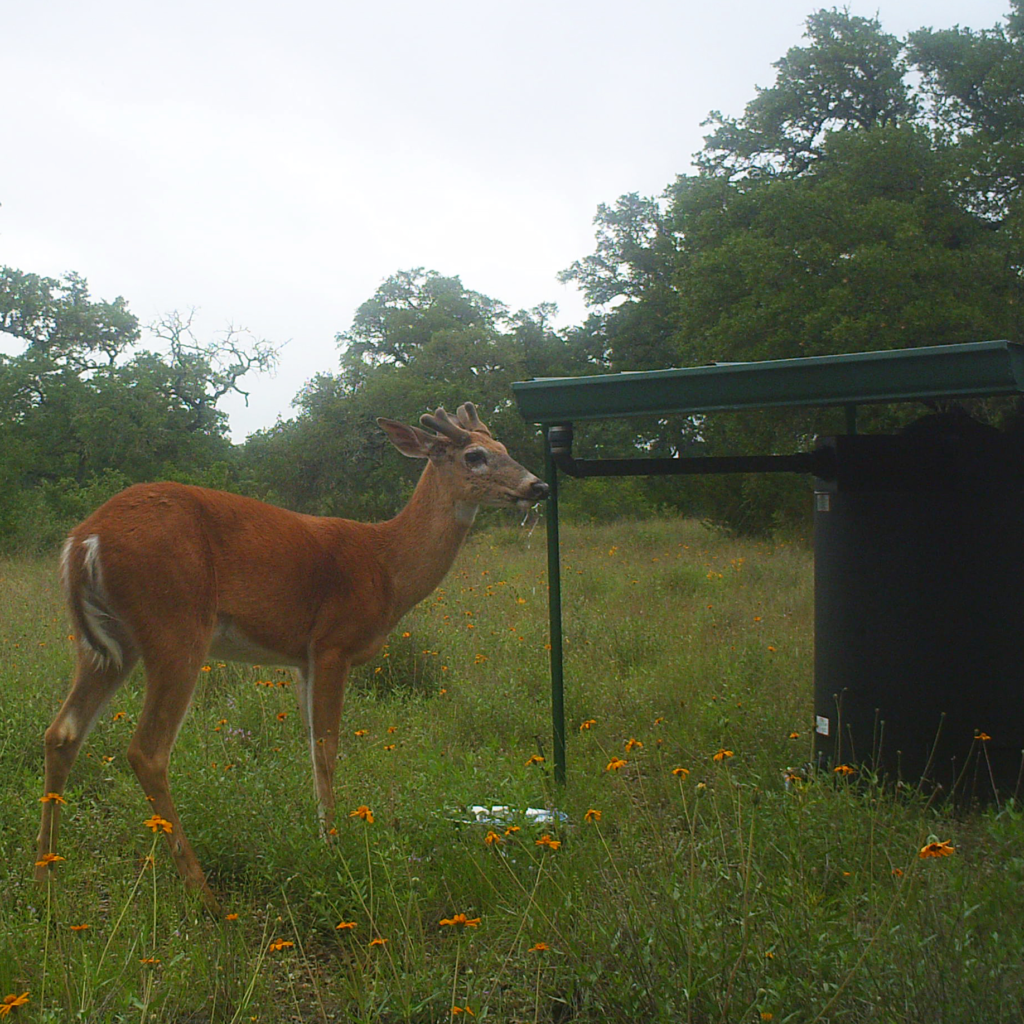 Water for Wildlife: Tuesday, August 24th, 6:00-7:00 PM
Water for Wildlife: Tuesday, August 24th, 6:00-7:00 PM
An important part of Wildlife Management, or managing for native Texas wildlife in general, is providing water for the wildlife on your land – especially during the hot summer months. During this one-hour webinar presented by Plateau Wildlife Biologist, David Riley, we will discuss ways to increase water retention on your land and how to provide supplemental water sources for that wildlife. Joining David, Braun & Gresham Attorney and Counselor Carly Barton will discuss legal considerations for damming water on your property. Time will be provided at the end to address your questions.
Register
Miss a date? Don’t worry! You can watch our on-demand webinars at any time by visiting our event directory, or catch up on June webinars here.
On-Demand Webinar: Wildlife Management Mid-Year Check In
Midyear is a good time to review your plan and confirm your expectations and goals. At halfway through the year, you should assess what activities have been accomplished, confirm adequate record keeping, plan the rest of the year, and get help if needed. This webinar covers the importance of getting started or keeping up with your activities at the mid-year point. We provide examples of activities well suited for after midyear, and how to set yourself up to never get behind again.
On-Demand Webinar: Birding Basics for Landowners
Whether you are in Wildlife Management or not, an exciting activity for many landowners is watching and identifying the various birds that frequent your property. In this one-hour webinar, Plateau Wildlife Biologist Danielle Belleny provides some basic insights and tools to help you get started birding! Danielle covers some basic behaviors, sounds, and appearances of birds in Texas. She also provides suggestions of native plants that will help attract and benefit birds on your property.
On-Demand Webinar: Wildlife Management Q&A for Plateau Clients
As a part of our landowner family, we want to be available to answer our client’s questions about appropriate Wildlife Management activities, record-keeping strategies, county requirements and expectations, and more. Landowner Account Manager Kameron Bain and Tim Milligan with Landowner Services answer pre-submitted and live questions during this one-hour presentation.
On-Demand Webinar: Managing Small Acreage Properties for Wildlife
As fragmentation of Texas wildlands increases more and more landowners are struggling to manage wildlife on their small acreage property. During this one-hour webinar presented by Plateau Senior Wildlife Biologist, Tucker Slack, we discuss different management techniques and activities that landowners can utilize to manage for several different wildlife species. Additionally, Tucker covers the importance of wildlife management cooperatives and how they can benefit your management.
For questions or assistance registering for an upcoming webinar, please contact (512) 894-3479 or plateau@plateauwil1dev.wpenginepowered.com.
On-Demand Webinar: Tools to Limit Your Risk & Protect Your Land
By David Braun & Joanne Hatton, Braun & Gresham, PLLC Attorney & Counselors
As friends, family, and other guests enjoy land for recreational activities such as hunting, swimming, and off-road adventures, landowners could be putting themselves and their property at risk. During this webinar Braun & Gresham Attorneys, David Braun and Joanne Hatton, discuss risk management tools for owners of rural land. David and Joanne cover common concerns landowners should protect themselves against, and layers of protection they should consider such as business entities, insurance, emergency protocols and more.
If you have questions or would like more information, please contact Braun & Gresham at (512) 894-5426 or info@braungresham.com.
Recovering America’s Wildlife Act: A Monumental Step in Wildlife Funding for Texas
By David Riley & James A. Hall, Wildlife Biologists and Registered Property Tax Consultants

As a biologist, I never thought that I would be absorbed in politics. However, the introduction of Recovering Americas Wildlife Act (RAWA) in 2016 not only caught my attention but drew the attention of lawmakers in Washington, D.C. as an important piece of legislation to invest in the protection and conservation of wildlife, and wildlife habitat throughout the nation.
The article below was originally posted in 2018, as the RAWA bill was going through its second round in the U.S. House of Representatives. Unfortunately, this introduction of the bill and subsequent versions never made it to the floor for a vote. The bill has been introduced again and this time with a lot of bipartisan support. In April 2021 Rep. Dingell (D-Michigan) introduced the bill (H.R. 2773) for the 117th session of Congress and it was referred to the Natural Resources Committee. In July Sen. Heinrich (D-New Mexico) introduced a companion bill (S. 2372) in the Senate that has been referred to the Committee on Environment and Public Works. As this bill makes its way through Congress I wanted to republish the article that discusses the importance of this legislation and the impacts it can have on protecting and conserving wildlife throughout our great nation.
History of Conservation Legislation
On September 2nd, 1937, Franklin D. Roosevelt signed on a dotted line, which enacted one of the greatest conservation funding acts in the history of the United States. The Federal Aid in Wildlife Restoration Act, also known as the Pittman-Robertson Act (PR), essentially allocated the 11% excise tax that is placed on firearms and ammunition back to the states to be used for wildlife conservation.
Over the years the Pittman-Robertson Act has seen many revisions to include other taxes on handguns and archery equipment. The Dingell-Johnson Act (DJ) of 1950 was a similar law, produced to obtain funds from sportfish and boating in order to aid in the management and restoration of state fisheries. Next year we will celebrate the 85th anniversary of the Pittman-Robertson Act, and since its induction over $14 billion has been placed in Wildlife Restoration Trust Fund for conservation.
Unfortunately, since the PR and DJ Acts, there have been very few successful attempts at allocating more funds to wildlife conservation, making the Recovering Americas Wildlife Act (RAWA) important legislation for conservation efforts. It would allocate an annual distribution to the states, including potentially $50-65 million to Texas. This would nearly double current state funding, making massive strides towards encouraging the restoration of flora and fauna species of greatest conservation need.
RAWA Funding & Allocation
Funding of this magnitude is always followed by the question, where is the money going to come from? The simplest answer to this question is that the $1.3 billion would come from existing revenue from oil, energy, gas, and mineral fees on federally operated lands. Currently, the money is allocated to the Department of Treasury, but RAWA would reallocate these funds to the individual states based on size and need. The funds would be controlled by the states’ fish and wildlife agencies, such as Texas Parks and Wildlife Department.
Another critical question – how is the money going to be spent? For government entities, additional funding can be utilized for expanding research programs, land allocation for parks and preserves, and outreach aimed at benefiting declining species. However, state government-funded programs (while highly important and often successful) face bureaucratic red-tape, are bound by conciliation with competing interests, and are frequently aimed towards providing recreational activities in public space.
In Texas, these programs are often fluctuating and severely underfunded, and in many cases, largely allocated solely for the benefit of game animals and sportfish. Compounding the problem, these public lands account only for a fraction of the open space in Texas. In this state, the burden of land management remains undoubtedly on the shoulders of the private landowner.
Importance of Conservation Funding
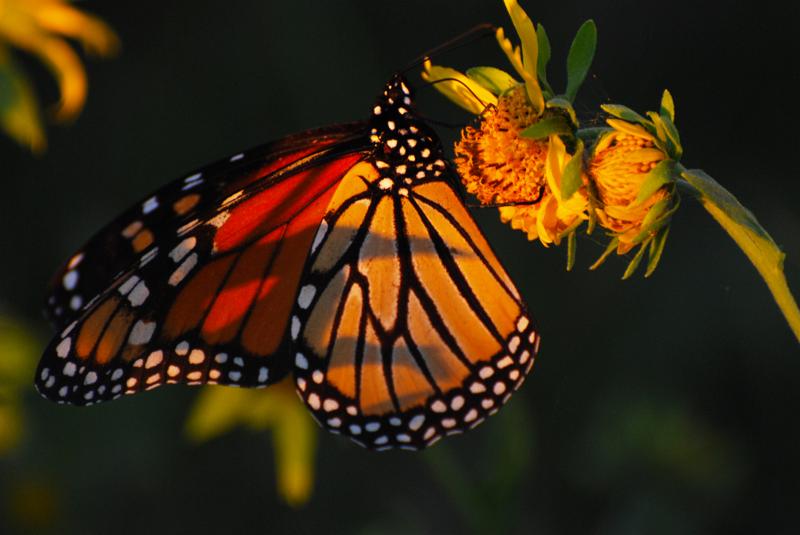 Is it generally accepted that habitat loss and degradation are one of the chief causes of declining species. Due to the state being more than 95% privately owned, proper land stewardship must be encouraged. Financial incentives will be the principal motivator for these landowners to manage their properties for the benefit of non-game species. Once implemented by federal or state initiatives, these incentive programs can then be further encouraged by private sector groups who have greater flexibility in providing the services needed by the landowner. Many consulting firms are in a unique position to offer technical guidance and assist with the implementation of management concerns.
Is it generally accepted that habitat loss and degradation are one of the chief causes of declining species. Due to the state being more than 95% privately owned, proper land stewardship must be encouraged. Financial incentives will be the principal motivator for these landowners to manage their properties for the benefit of non-game species. Once implemented by federal or state initiatives, these incentive programs can then be further encouraged by private sector groups who have greater flexibility in providing the services needed by the landowner. Many consulting firms are in a unique position to offer technical guidance and assist with the implementation of management concerns.
For example, Plateau Land and Wildlife Management is in a unique business niche in central Texas, dealing primarily with the consultation of the 1-d-1 wildlife management valuation. Landowners incur enormous tax savings on their properties by managing them specifically for wildlife, as they would under the agricultural valuation. While we all rely on agriculture to provide food and other products for human consumption, not all lands are easily tamed for sustainable production. The Edwards Plateau provides excellent examples of marginally productive agricultural land which would be better suited as wildlife habitat.
Another example of an incentive program includes the promotion of habitat for migrating Monarch butterflies. Several of these programs target landowners who are paid to establish pollinating and host species such as antelopehorn milkweed, a vital plant that the Monarch requires for propagation. While indisputably beneficial, this activity focuses on only one species and does not provide long-term financial security for ranchers who ultimately seek a decision between livestock and wildlife management options.
Furthermore, few of these programs address the fragmentation and incongruity of management practices across the landscape. Large-scale and incentive-based land preservation is paramount, where unadulterated habitats can be conserved, monitored, and properly managed. While the government purchase of land is prohibitively expensive and relatively rare, existing landowners can be incentivized through mitigation funding or tax incentives to conduct stewardship activities or create conservation easements for the long-term protection of the state’s most sensitive habitat. Landowners are then no longer burdened with the need to fragment their land, which will then be managed without cohesion or even the knowledge that a natural resource problem exists. For a perennial program to succeed, money must continue to be funneled to those that control ownership and ultimately management of the land, under the guidance of natural resource professionals in both the private and public sectors.
Regardless of the mechanism or the entity that manages it, the current reality is that conservation funding is not expected to trend upwards. This legislative session may prove critical in the protection of our valued natural resources. Each state will implement different approaches for maximizing the efficiency of those dollars. Providing the tools and inspiration necessary to affect change will one day be reflected upon by future generations as the crucial point in the protection of that which we exploit.
Field Notes: Pictures & Highlights of Properties in Wildlife Management
Ever wonder how Wildlife Management is benefiting landowners’ property and the wildlife that lives on it? Here are some photos and highlights, from Plateau’s field staff and game cameras, of successes and small victories our landowner customers are seeing on their property.
Watch Out for Asp Caterpillars
When visiting your property, you’re likely to encounter many new and interesting types of wildlife. And while a desire to learn more about the plants and critters on your land is great, always be cautious before handling wildlife you newly discovered. For example, meet the asp caterpillar. Don’t let its beautiful golden-blonde hair fool you, these hairs may be soft or they might not (we don’t recommend trying to find out). Accidentally brush up against it, and you will quickly be alerted to its presence. These little hairs (spines) pack quite a punch… an instant burning sensation, that is quickly met with some noticeable skin irritation. Asp caterpillars should be avoided, their spines are venomous and the degree it may affect someone varies — sometimes it is localized burning or it can radiate up your limb; it could cause nausea, headache, etc (reactions may vary from person to person). For assistance in identifying flora and fauna species, we recommend downloading the iNaturalist app. You can also send us a photo and have a Plateau biologist identify it for you!
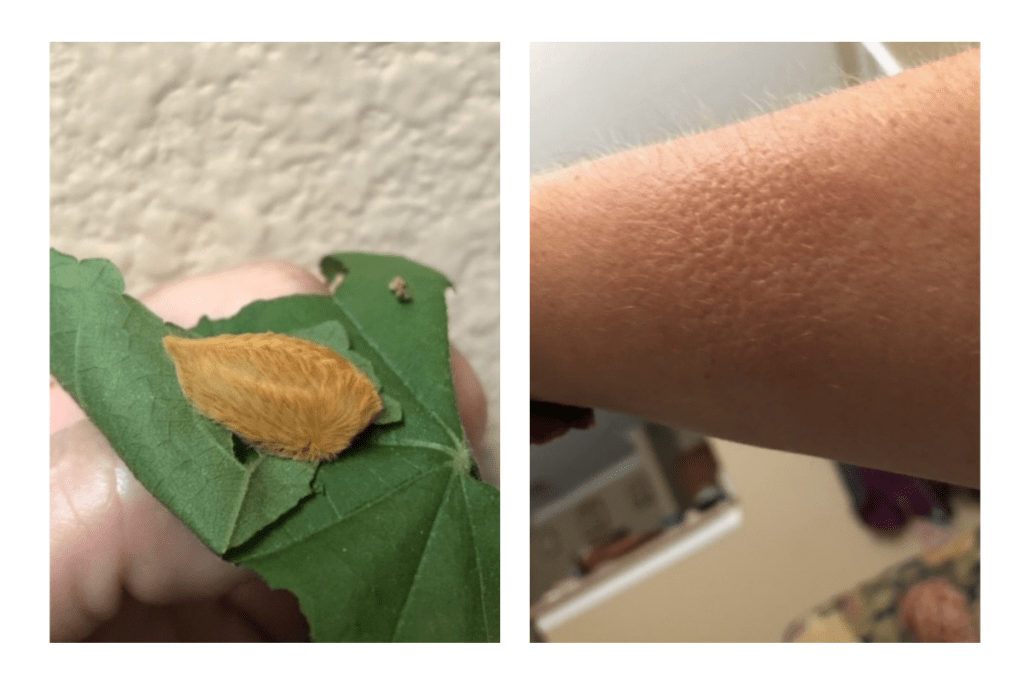
Barking Frog (Craugastor augusti)
The barking frog can be found around limestone caves, crevices, and ledges in the eastern and southern edges of the Edwards Escarpment with some scattered isolated locations in west Texas. This frog is nocturnal and secretive, rarely venturing out into the open, and can be difficult to detect. It is called the barking frog because its call sounds like the barking of a small dog and only calls on a few rainy nights throughout the year (vocalizations vary by area). Juvenile barking frogs (like the one in the photo) have a white band that goes across their otherwise dark back. Learn more about different Texas wildlife species by following us on Facebook! Each Friday we highlight unique flora and fauna found across the state.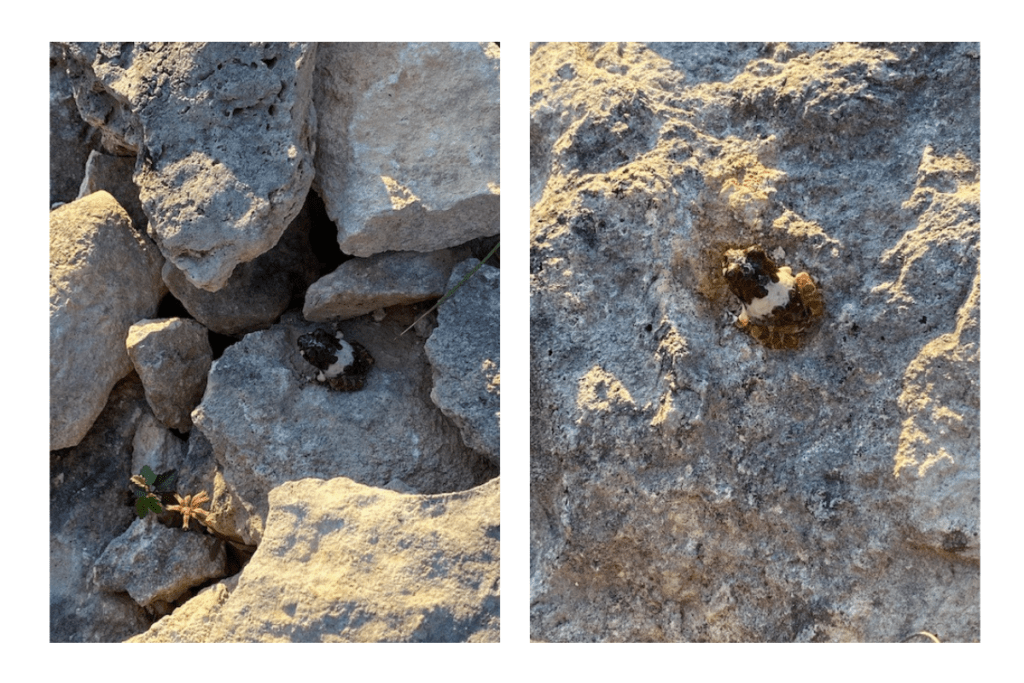
Turkeys in Kerr County
A Plateau landowner in Kerr County spotted 7 young turkeys utilizing the platform feeder on their property! Providing supplemental food and water becomes especially important during the hot summer months when resources dry up and become scarce. If you’re in Wildlife Management, providing supplemental food and water count as qualifying activities. At Plateau, we offer various feeders and water tables to meet your property and wildlife needs. Check out our products, and if you have questions give us a call at (512) 894-3479!
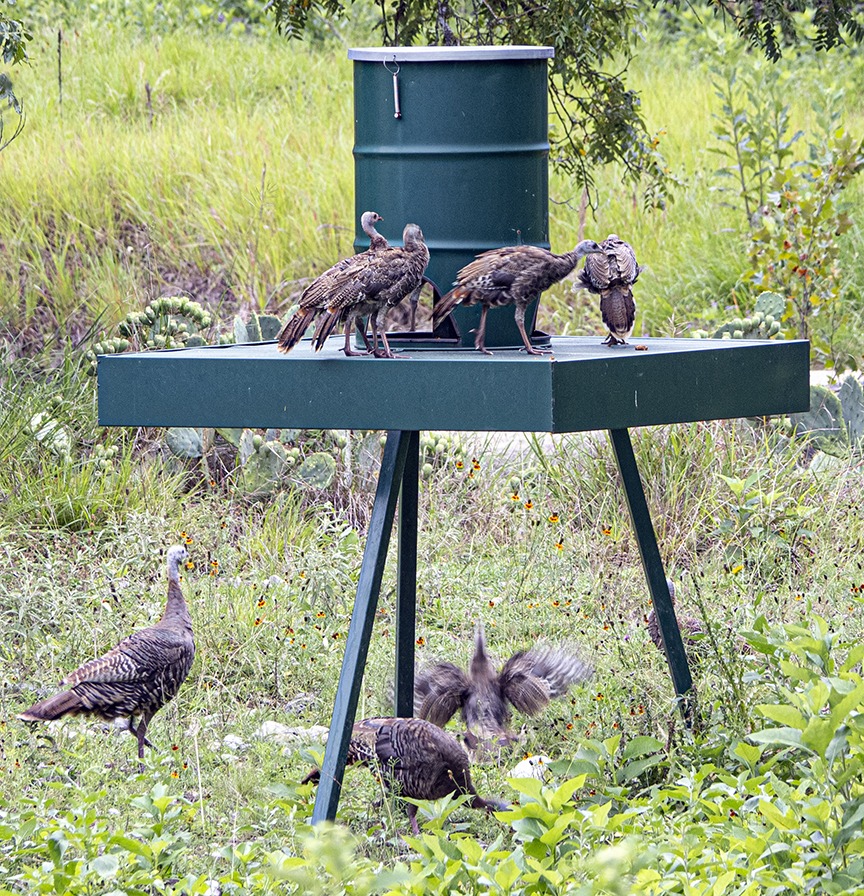
So many of you are out there doing great work. We appreciate you, and so do the native wildlife on your property and across Texas. Large or small, you are making a difference. Look for more great examples of wildlife and landowner successes and victories in upcoming Seasons Newsletters!
News for Texas Landowners
Helping Texas’ Unique Snakes Through Research
Article by Kerry Halladay for Texas A&M AgriLife
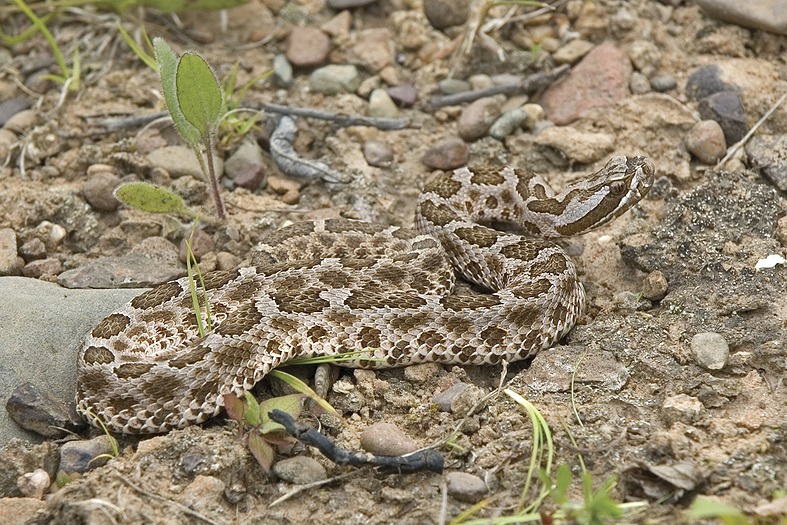
The Texas A&M University Natural Resources Institute, NRI, a unit of Texas A&M AgriLife, has been researching three threatened snakes unique to Texas: the Louisiana pinesnake, the eastern indigo and the massasauga rattlesnake.
“Snakes are vilified, but they are an important part of the ecosystem,” explained Danielle Walkup, NRI research scientist.
“Snakes tend to be in the middle of a food web,” she continued. “They eat smaller things like rodents, so they can help with rodent control and can also be food for bigger things, so they are an important part of the food web. They are unique creatures.”
Most of NRI’s work with the trio of threatened snakes deals with habitat restoration and assessment, partnering on early-stage reintroduction efforts, and pursuing general knowledge about the species…
Bipartisan Wildlife Proposal Would Enhance Fish and Wildlife, Add Jobs, and Grow Businesses in Texas
News Release by Texas Parks & Wildlife Department

During the pandemic, Texans headed back to nature in record numbers, with more people visiting state parks, hunting, fishing, and boating than ever before. A new congressional proposal aims to tap that exploding interest by investing more than $50 million per year in Texas for wildlife recovery and related public education and recreation, a move expected to boost the state’s already booming nature-based economy into overdrive.
The bipartisan Recovering America’s Wildlife Act, H.R.2773, would provide $1.4 billion to state and tribal wildlife conservation initiatives to support at-risk wildlife populations and their habitats. The funding would come from existing revenues with no new taxes.
If passed, this legislation would send grant funds flowing across Texas to nonprofit organizations, nature centers, universities, landowners, and many others for projects to conserve vulnerable wildlife before they become endangered…
Comal County Group, Hays County Neighbors Aim to Spare Some Nature from Sprawl
Article by Lisa Dreher for The Herald-Zeitung
 People are flocking to the Texas Hill Country for its lush and rolling hills, so some in Comal and Hays counties are working together to preserve it.
People are flocking to the Texas Hill Country for its lush and rolling hills, so some in Comal and Hays counties are working together to preserve it.
The Comal County Conservation Alliance recently held a virtual meeting with Hays County Precinct 3 Commissioner Lon Shell.
Shell talked about Hays County’s Parks and Open Space Advisory Committee, which supported a bond to preserve land from excessive development.
Both counties’ conservation efforts for the past several years have included 2,382 acres of land called El Rancho Cima, a former Boy Scouts camp…
Healthy Creeks Initiative Underway
Press Release by Hill Country Alliance
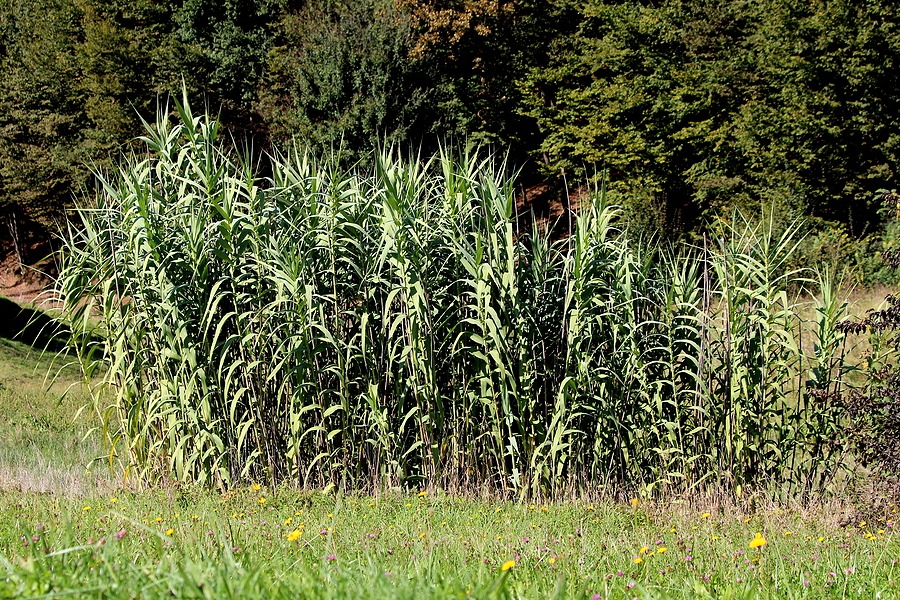 This month, contractors will begin the annual control efforts to manage Arundo along the Pedernales River and several tributary creeks. Arundo, also referred to as Giant Reed or Carrizo Cane, is a non-native, invasive plant that can take over creeks and rivers.
This month, contractors will begin the annual control efforts to manage Arundo along the Pedernales River and several tributary creeks. Arundo, also referred to as Giant Reed or Carrizo Cane, is a non-native, invasive plant that can take over creeks and rivers.
Since 2016, the Texas Parks & Wildlife Department (TPWD), Hill Country Alliance (HCA), City of Fredericksburg, and other organizations have partnered with volunteering landowners through the Healthy Creeks Initiative to control Arundo and enhance the creek-side (or riparian) habitat along Barons Creek, Town Creek, and other portions of the Pedernales River Basin primarily upstream of Johnson City.
Arundo, which has a cane-like stem that looks similar to bamboo, is a highly invasive, non-native grass that can grow more than 25 feet tall…
2020 Texas Rural Land Value Trends Report Released
Blog by Tiffany Lashmet for Texas Agricultural Law Blog
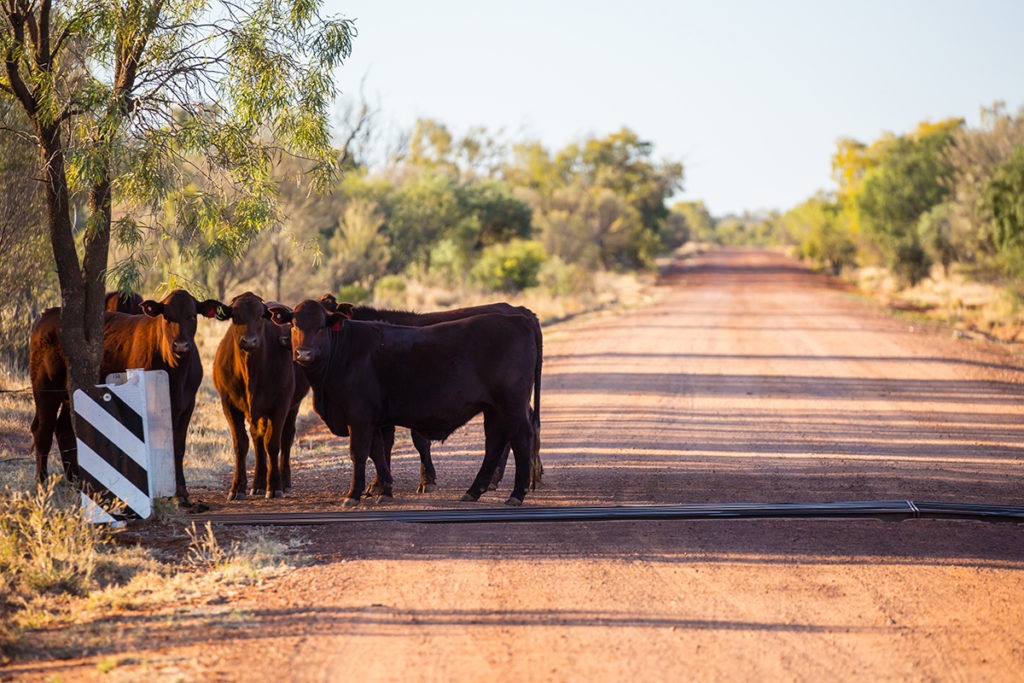
One of the most useful resources for rural Texas landowners is the annual Rural Land Value Trends Report published by the Texas Chapter of the American Society of Farm Managers and Rural Appraisers. The 2020 Report was recently released.
This report breaks Texas into seven regions and then each region is broken into smaller sub-regions. The report then offers information regarding land prices and leasing rates for various types of property from irrigated cropland to rangeland to CRP land. Additionally, this is the only publication I am aware of that publishes average hunting lease rates for the Lone Star State.
Here is an example of the data collected for each sub-region. This information is for the Northern Panhandle and South Plains…






Sorry, the comment form is closed at this time.